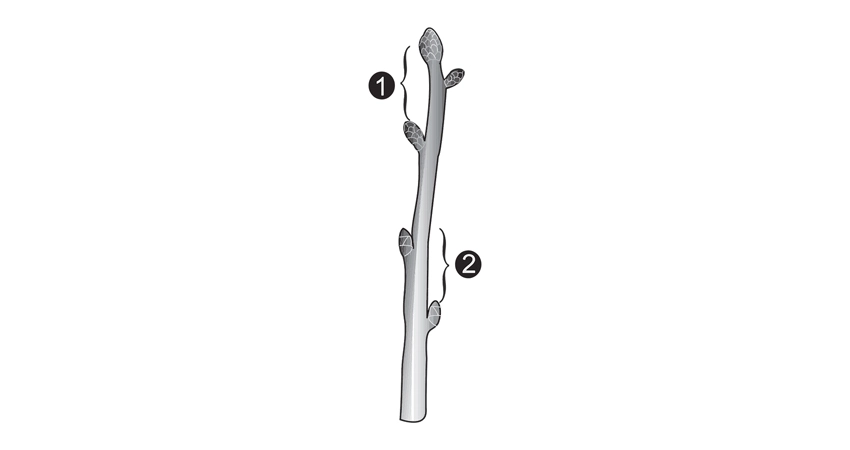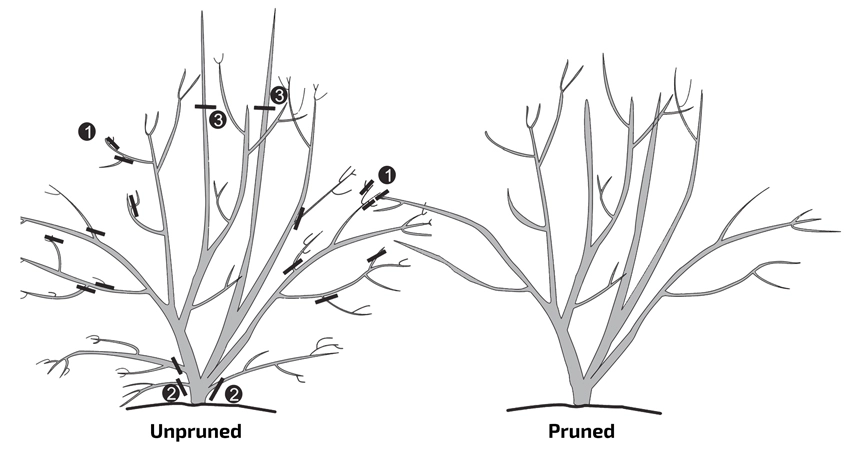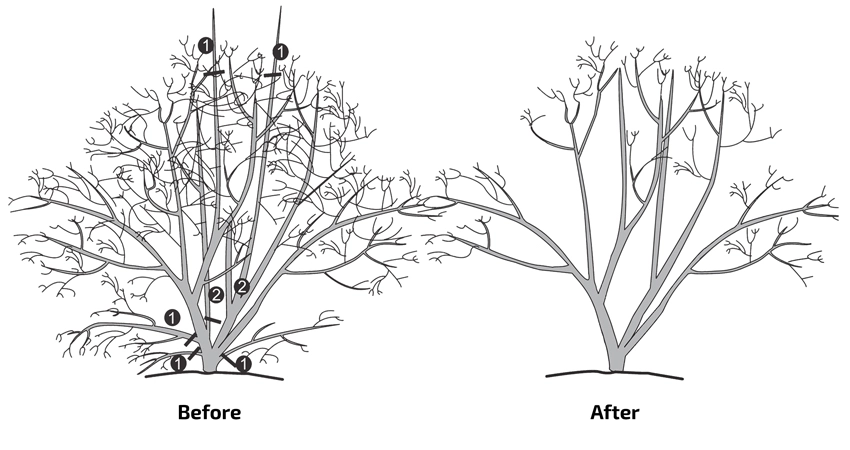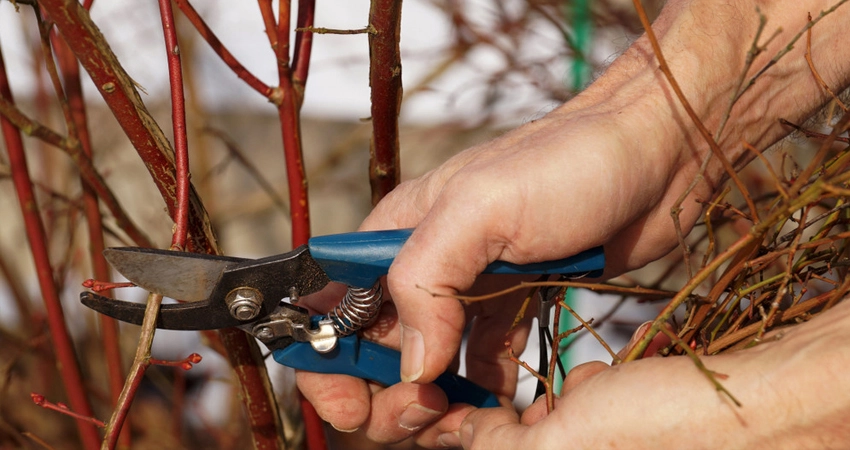Menu
Pruning Methods and Periods for Blueberries
Throughout the enduring lifespan of blueberries, their economic vitality flourishes resplendently within thirty to fifty years.
This golden era necessitates meticulous planning and the deployment of a suite of sophisticated cultivation techniques to maintain a delicate balance—central to which is the management of the equilibrium between vegetative and reproductive growth, ensuring consecutive years of high-quality fruit production.
Blueberries, in their unique manner, construct their realm. Departing from the mainstream style of many fruit trees that aspire to a solitary trunk’s proud solitude or elaborate branch configurations, blueberries embrace a free-form multi-axis branching pattern, weaving a dense canopy akin to a forest.
Left unpruned for over a decade, blueberry bushes may revel in a frenzy of wild growth: their stature soaring, canopies broadening, and foliage thickening into a labyrinthine challenge that tests both the delight of harvest and the wisdom of management.
Beneath the profound canopy, not only do the fruits become hidden treasures, elusive to the touch, but also the abundance of flower buds, though teeming with promise, face nature’s ruthless culling come late summer. This leads to annual fluctuations in yield, inconsistent fruit quality, and a perplexing array of maturation timelines.
Against this backdrop, the art of pruning emerges as a vital practice.
More than just a display of skill, pruning constitutes a pivotal strategy in assuring quality and quantity. By meticulously orchestrating each branch, it enables warm sunlight to penetrate the verdant layers, nurturing every corner of the fruit and fostering uniform ripening.
Furthermore, through judicious regulation of fruit-bearing branches and flower bud counts, pruning can effectively mitigate physiological fruit drop, and reduce the biennial-bearing phenomenon, thereby stabilizing yields and enhancing fruit quality.
This blog delves into the specifics of how pruning techniques achieve these objectives, offering scientifically grounded management guidance to blueberry cultivators.
Table of Contents
The Double-Edged Sword of Pruning in Blueberry Cultivation
Pruning, in the context of blueberry cultivation, reveals a complex dual nature, with its effects significantly influenced by factors such as the blueberry variety, the intensity of pruning, and the timing of its application.
Remarkably, even when pruning of the same degree is applied at identical periods, the outcomes can be starkly contrasting when dealing with blueberry plants of different ages or vigor. At times, it acts as a positive stimulus for tree growth, while in other instances, it imposes necessary restrictions on growth.

1. Impact on Tree Growth
Pruning strategies directly influence the growth pattern and development of new shoots. During the juvenile stage of blueberries, moderate light pruning effectively stimulates the robust growth of future primary branches. Conversely, heavy pruning restrains the extension of new shoots.
As blueberries mature and exhibit strong vigor, heavy pruning can paradoxically invigorate vigorous new shoot growth, albeit potentially leading to a more intricate tree structure with excessive branch elongation.
2. Effect on Fruit Yield
By reducing flower buds, pruning indirectly affects fruit production, typically resulting in fewer fruits per adult tree but promoting larger remaining fruits.
However, heavy pruning of young trees may delay the formation of flower buds. Conversely, on weak plants, such pruning can astonishingly stimulate robust new shoot growth, increasing fruit size and boosting yield.
3. Influence on Quality
While it is generally believed that more severe pruning favors individual fruit enlargement, this often comes at the cost of reduced sugar content, inferior color, and delayed maturity, posing potential threats to fruit quality.
Blueberries are no exception to this quality trade-off. Thus, while pruning can increase fruit weight at the expense of some sugar content and color, finding the optimal balance between enhancing yield and ensuring premium quality becomes the paramount consideration in blueberry pruning practices.
Names and Properties of Blueberry Branches
Branch Name | Definition and Characteristics |
Crown | The upper part gathered at the root, connected to the main axis branches. |
Primary Lateral Branch(Cane) | Develops from new shoots, and has flowered and fruited 2-3 years prior, forming the main branches of the blueberry canopy. |
Old Branch | A branch over 2 years old, located above or amidst the main axis branches, which can be thick or thin, producing new shoots and bearing flower buds. |
New Shoot | Grows in the current year, bearing leaves; axillary buds form flower buds, becoming fruiting branches after dormancy; typically, flower buds are at the tip, with leaf buds below. |
Buds | Divided into floral and leaf buds; floral buds contain multiple flowers forming an inflorescence. |
Lateral Branch | Grows on old or new branches, serving as the site for fruiting in the following year. |
Pruned Objects
Pruning Target | Characteristics | Treatment Method | Main Objective |
Old Branches | Over 5-6 years old, declining vitality | Remove old branches, ensuring at least 2 new primary canes annually | Renew plant vigor and maintain high yield |
Upper Part of New Shoots | Vigorously upward growth | Trim at the top 1/3 | Promote lateral growth and bud formation |
Downward-growing Branches | Close to ground or horizontal growth | Remove from above the root, retain upward-growing branches | Optimize tree shape, enhance ventilation and light penetration |
Internally Crossing Weak Branches | Within the canopy, stagnant growth | Remove | Improve light penetration and keep ventilated, increase yield |
Dense Bud Tips | Excessive bud clustering at stem tips | Moderate pruning before flowering | Prevent nutrient dispersion, enhance fruit quality |
Superfluous Basal Branches | Multiple thin branches at trunk base | Retain 2 primary canes, remove the rest | Concentrate nutrients, promote trunk health |
Damaged Branches | Affected by cold damage or pests/diseases | Identify and prune promptly | Prevent pest/disease spread, safeguard plant health |
Blueberry Pruning Period
Pruning of blueberries is undertaken during the dormancy period, stretching from November to March. This spans from post-leaf fall until just before the early spring rise in sap flow.
The reason for selecting this timeframe is rooted in the fact that the transportation of carbohydrates within the plant, from roots to branches, ceases around late autumn to early winter.
Some studies indicate that pruning conducted in mid-September can postpone flowering by about five days, thereby, in effect, safeguarding the blooms from potential late-spring frost damage.
In regions where late frosts pose a significant risk, pruning during this period might be strategically employed. Additionally, in areas prone to heavy snow or wildlife-induced damage during winter, pruning may also take place just before bud burst, in consideration of these environmental hazards.
Blueberry Pruning Techniques
1. Pruning for Blueberry Seedlings Aged 1-3 Years
After planting, blueberry seedlings should not be pruned for the first two to three years, except for removing diseased or dead branches.
The rationale behind withholding pruning is that by retaining non-fruiting shoots or canes, the leaves that sprout from these will produce nutrients. These nutrients are vital for fostering root development and the growth of the shrub itself.
Flower buds that have already formed or are in the process of forming should be removed, as they significantly drain energy from young trees. This energy depletion hampers the growth of new shoots and roots.

2. Pruning Blueberry Trees Aged 4 to 5 Years
Three years after planting, the height of the blueberry tree will have reached approximately 60 to 120cm, depending on the variety, marking the formation of its basic structure.
Starting from the fourth year, many fruiting branches begin to appear. Ideally, flower buds within the lower 30cm of the stems should be removed, and fruiting should be encouraged from the upper parts of the branches.
Dead, diseased, or pest-infested branches, along with those that are thin and weak, should be eliminated. Among the new shoots emerging from the base, select and retain the two most vigorous ones to serve as main trunk branches in the coming autumn, while the rest of the shorter shoots should be pruned back.

3. Pruning Blueberry Trees Aged 5 to 6 Years
When blueberry trees reach 5 to 6 years of age, it’s time to remove thin and weak branches, allowing virtually all fruiting branches to bear fruit effectively.
The aim should be to cultivate around 5 to 6 primary scaffold branches and to eliminate any overly intricate branching within the tree’s structure.
To ensure ample sunlight penetration to the tree’s interior and facilitate easier management, old branches, inward-growing branches, downward-facing branches, and any superfluous growth should be pruned away. This practice promotes better aeration and light distribution, contributing to a healthier and more productive tree.

4. Pruning of Mature Blueberry Trees
Pruning of main axis branches
Regular Pruning of Main Trunks: As blueberry saplings mature into trees, regular pruning becomes crucial for maintaining high yields.
Particularly for long-lived perennials like highbush blueberries, good pruning practices combined with comprehensive management can sustain their vitality for up to 50 to 70 years.
Main trunks should be cut back at their base when they reach around 5 to 6 years old to stimulate new shoot growth and prevent a decline in productivity.
Thinning Out Old Branches and Renewing Main Trunks: The focus lies in removing older branches with diminished fruiting capacity, as well as thick, main branches bearing short and sparse fruiting twigs, thereby encouraging the growth of robust new branches.
Ideally, a complete renewal of the main trunks should be carried out every five years, with about 20% of the tree’s stems being pruned annually. This maintains a roughly 20% rate of renewal, ensuring sustained high productivity through an invigorated metabolism of the tree.
Identifying and Pruning Low-Productivity Stems: Promptly remove stem sections that bear no fruit or lack flower buds to prevent premature aging of the plant.
For specific varieties, such as Northern and Southern Highbush blueberries, which experience a significant drop in productivity once branches reach 4 years old, and Rabbit-eye blueberries after 6 to 7 years or more, these older stems should be prioritized for removal to facilitate the growth of vigorous new shoots.
Customized Strategies for Twig Management: Adapt pruning strategies according to the specific needs of different blueberry varieties. For instance, with Rabbit-eye blueberry varieties that readily produce upright canes, about 10 main trunk branches are retained, whereas for other varieties that struggle to produce branches, this number is reduced to 8 or fewer.
Additionally, based on the variety’s characteristics, thin out or head back aging branches in early spring to encourage the development of new lateral branches. The exact approach should be tailored to the growth status of the shoots—considering factors such as their number, thickness, and length—allowing for flexibility in execution.
Adjusting Fruit-bearing Areas Similarly
Considering factors such as the thinning of main branches (disbudding), light penetration, ventilation, and ease of management, fruit-bearing areas also undergo thinning or pruning.
Pruning branches enable the carbohydrates formed in leaves to be utilized for the growth of new shoots, the formation of flower buds, and the enlargement of fruits.
Cutting Back Long Fruit-bearing Stems for Marketable Fruits
By trimming the tips of fruiting stems to a certain extent and reducing the number of flower buds to 1/3 to 2/3, the number of fruit clusters is limited, resulting in uniform fruit size and increased individual fruit weight. Notably, removing longer stems with numerous flower buds promotes the production of evenly large fruits.
Conversely, stems that are both thin and short but carry many flower buds should either be entirely removed or pruned back to where the flower buds are, shortening them and leaving leaf buds (retaining leaf buds). Even if such stems are retained, they yield smaller fruits in greater numbers, which is not advantageous.
Blueberry Pruning Guide
Each year, blueberry plants produce numerous new shoots from their base, requiring careful selection during pruning to remove weak stems and retain only 2 to 3 sturdy and vigorous new shoots, thereby establishing healthy and productive main trunk branches.
These main trunks will serve as the backbone of abundant harvests over the next 5 to 6 years; however, with time, their vigor diminishes, leading to a decline in fruit quality.
Consequently, the crux lies in systematically replacing aged main trunks annually with new, vibrant productive branches, embodying the essence of the blueberry pruning strategy.
To ensure premium fruit quality, the ideal number of main trunks per blueberry plant should be limited to 8 to 10; exceeding this count may likely compromise fruit quality, resulting in a downturn.

Pruning Intensity and Tree Response
The growth characteristics of blueberry trees are significantly influenced by variations in cultivars and cultivation conditions, leading to differing levels of tree vigor. Consequently, pruning strategies must be meticulously tailored to the individual condition of each tree to achieve optimal pruning outcomes.
Taking rabbit-eye blueberries as an example, these trees exhibit robust vigor, with frequent new shoot emergence and upright suckering, forming large canopies that expand rapidly and develop complex internal structures. Amidst such exuberant growth, the core of pruning lies in effectively managing and simplifying these dense, tangled branches.
In contrast, northern highbush blueberries produce fewer new shoots, shifting the focus of pruning to how strategic cuts can foster the formation of fruitful branches and support healthy fruit-bearing.
General observations indicate that light pruning without excessive reduction can result in dense, disorderly branches, while weak and elongated shoots struggle to generate robust new growth. Conversely, heavy pruning not only stimulates vigorous new shoot growth and promotes vegetative growth, but it may also come with the side effect of reducing flower bud formation.
Moderate pruning, however, skillfully balances vegetative growth with reproductive growth, promoting the superior development of flower buds—especially beneficial for weaker cultivars or situations demanding enhanced vegetative growth. Regulating fruit load and judiciously thinning flower buds are crucial steps in cultivating large fruit.
For blueberry trees that are already strong and vigorously growing, excessive heavy pruning risks disrupting their growth balance. Light to moderate pruning approaches are more suitable, or judicious guidance of main trunk growth, to maintain equilibrium.
Notes on Blueberry Pruning Techniques
- Ensure pruning shears are sharp and clean. Dull shears delay tissue regeneration at the cut site or increase the risk of disease infection.
- Sterilize pruning shears before use. Soaking them in a 50% dilution of sodium hypochlorite (bleach solution) for 2–3 seconds is effective.
- When pruning diseased branches, cut 2–3cm below the visibly infected area. Immediately disinfect pruning shears after cutting diseased parts.
- Place pruned diseased branches in a plastic bag for isolation before disposing of them by burning.
- Collect pruned branches separately and dispose of them away from the blueberry field.
- When cutting thick branches, pushing the shears towards the blade makes the cut easier, producing a cleaner cut and facilitating the break.
- Assess the tree before pruning to quickly identify what should be pruned first.
- Have a clear objective for pruning and anticipate the outcome.
- During the young tree stage (1–3 years after planting), flowering and fruiting can prematurely age the tree.
Get in touch with us!
From custom light planning, to tailored quotes, and everything in between, our team of horticulture experts are always ready to assist.




